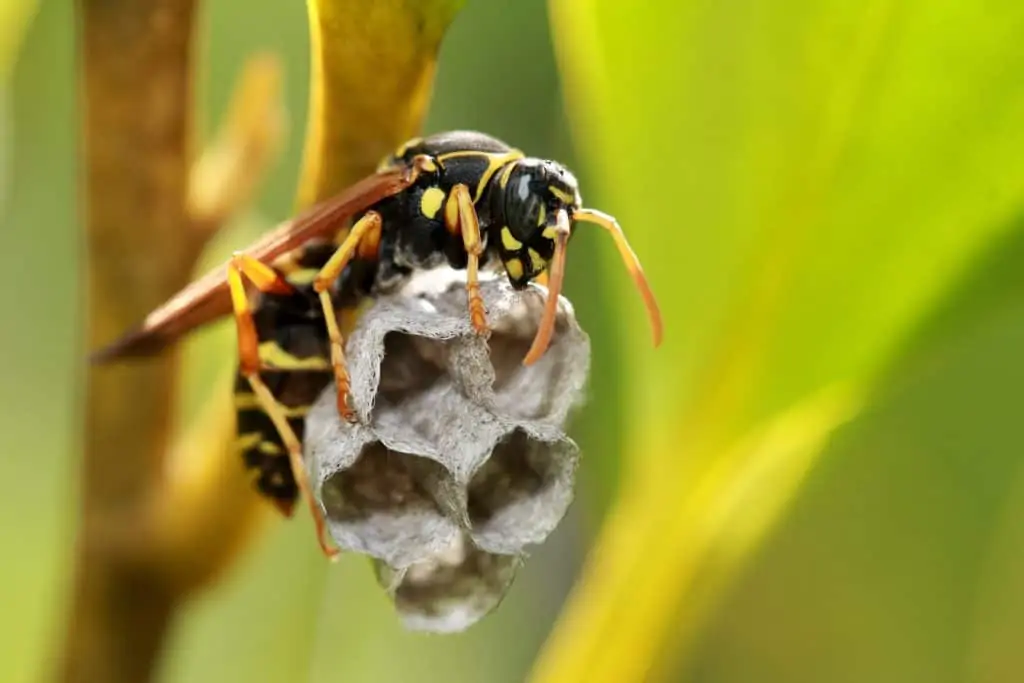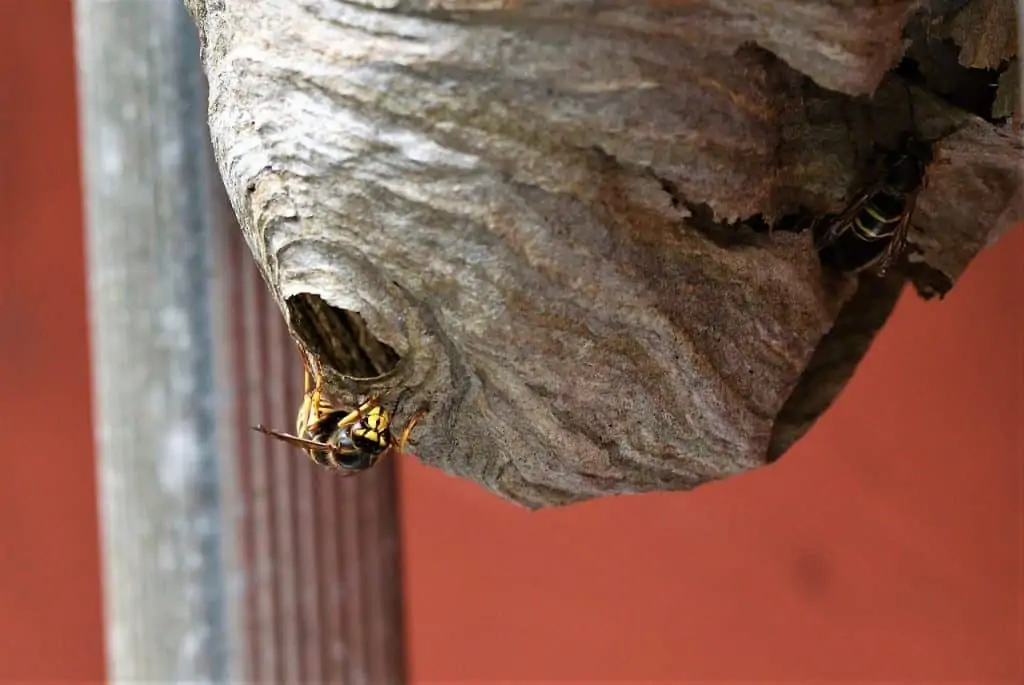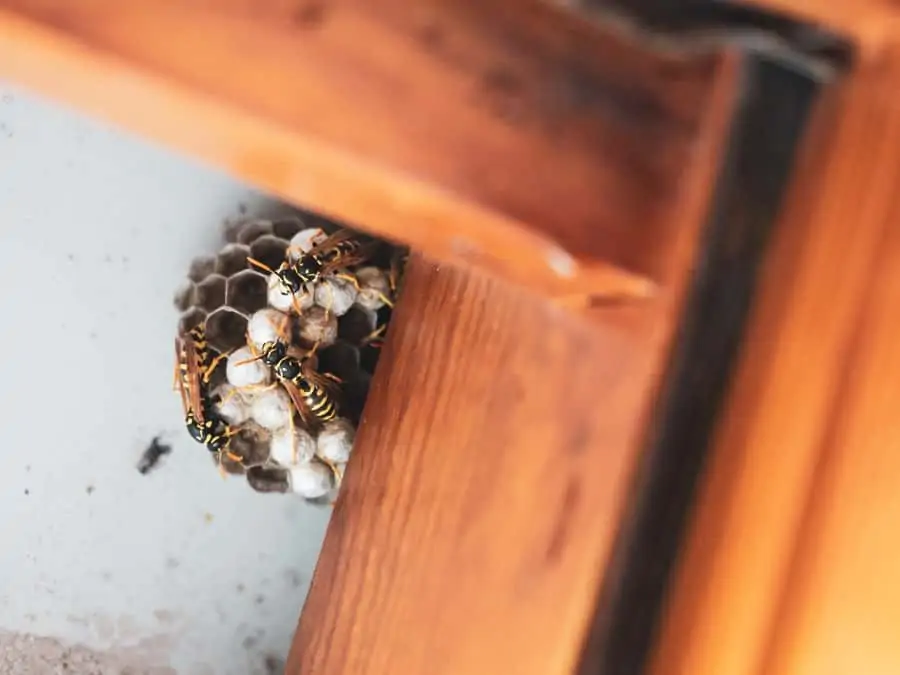Oh no! You’ve encountered a wasp nest and now you have to figure out how to get rid of it without getting stung. Is it possible?
Yes! You can get rid of a wasp nest without getting stung if you’re careful and follow our step-by-step guide below.
That said, there is no way to 100% guarantee you won’t get stung when romvong the wasp nest in question, so if you have sensitivities to wasp stings or bee allergies, it’s best to have someone else remove the nest for you.
On the other hand, if you’re ready and equipped to brave the wasp-nest removal journey, we’re here to help. But before we get into how to remove a wasp nest without getting stung, let’s first make sure the wasp nest you’re dealing with is active.
Keep reading.
Contents
How To Tell If A Wasp Nest Is Active
Wasps begin making their nests in early spring, when the weather is warmer.
Wasps are most active during the warmer months, often beginning in early spring. During this time, they will begin building their nests out of their saliva and chewed wood particles they collect or find. Wasp nests and hives may look different depending on the species of wasp you are dealing with. Some wasp nests may also appear in different locations around your property or home.
For the most part, however, most wasp nests are commonly located in eaves, below porches, in the corners of decks, in garages, garden sheds, along window sills, in basement windows, and even in attics.
If you come across a wasp nest between mid April and late June, you should expect for the nest to be active. However, if you come across a wasp nest in late summer leading into fall, it’s likely the nest has been abandoned.
Once a wasp nest has been constructed, it will only be used once. The hive does not return next spring and the nest will never again be used by other wasps.
The easiest way to tell for certain if a wasp nest is active is to keep an eye on it in the middle of the day while the weather is warm. A live wasp nest will be buzzing with wasps, many of them coming and going as they search for food.
Active wasp nests are also very noisy, with many housing upwards of 10,000 wasps at a time.
However, if you come across a wasp nest that is generally quiet and wasp-less, then you’re likely safe. To be sure, you can toss something at the nest from a safe distance. Once you confirm that the nest has been abandoned, you can simply knock the nest down with a pole or detach it with your hands if you can reach it safely, and discard it in a garbage bin.
On the other hand, there are some benefits to leaving an inactive and intact wasp nest alone. Since wasps are so territorial, if you leave an empty nest hanging and it survives until next wasp season, you are much less likely to have wasps rebuild their nest in a nearby location.
To Remove It Or Not To Remove It – Picking Your Battles
Wasps may look frightening, but they are much less likely to attack than you think.
Many people find wasp nests to be unsightly and unnerving, regardless of if they’re active or not. Other people don’t realize that wasp nests will never be reused and therefore remove them fearing the wasps will return next spring.
While we now know that wasps will not reuse an old wasp nest and that leaving an inactive wasp nest can help ensure wasps don’t return to that particular location, there are other reasons you might consider leaving a wasp nest alone.
Even active wasp nests can have their benefits, especially considering wasps are highly beneficial pollinators and predators. They can help serve as a natural form of pest control, feeding on a variety of garden-invading insects including aphids, caterpillars, and in some cases even cicadas.
If a wasp nest is far enough away that it will not cause you problems or put people you love in danger of getting stung, you might consider leaving it alone.
Besides, wasp nests are quite temporary, with most only being active for a few months at a time.
That said, there are occasions that call for the immediate removal of a wasp nest. If a wasp nest has been built in a particularly inconvenient location or if you, your family members, friends or pets are allergic to wasp stings, it would be in your best interest to have the nest removed.
So, how do you go about removing a wasp nest without getting stung? Let’s find out.
How To Remove A Wasp Nest Without Getting Stung – 5 Steps
Wasp nests are often paper-like in appearance and appear in spring or summer.
Before we cover how to remove a wasp nest without getting stung, let’s first talk about where wasp nests might be located. Many wasp nests can be reached standing on a step stool or ladder. However, some wasps build their nests quite high.
Depending on your abilities and the tools you have on hand, you’ll have to consider whether removing a wasp nest yourself is safe or realistic. If an active wasp nest is somewhere you cannot reach safely, we suggest you contact a professional pest control expert for help.
If you can reach and remove the wasp nest, then keep reading for the below steps to follow.
- Identify and Locate The Wasp Nest
- Have A Sturdy Trash Bag On Hand
- Approach The Wasp Nest Carefully After Dusk
- Cover The Wasp Nest With The Trash Bags
- Dispose of the Wasp Nest Far Away From Your Home
This video gives more detail on how to safely remove a wasp nest.
<iframe width=”560″ height=”315″ src=”https://www.youtube.com/embed/hEb538C13_U” frameborder=”0″ allow=”accelerometer; autoplay; clipboard-write; encrypted-media; gyroscope; picture-in-picture” allowfullscreen></iframe>
Step 1 – Identify And Locate The Wasp Nest
To get rid of a wasp nest, first you must locate it.
You don’t have to physically see a wasp nest to know there is one nearby. If you have noticed a swarm of wasps around your property on a daily basis, it’s time to go on a wasp nest hunt. The best way to find a wasp nest is to be vigilant.
Wasps are most active during the day when the weather is warm and the sun is out. Safely sit outside and pay attention to the wasps. Remember, wasps will not typically sting unless they feel threatened or antagonized. So long as you keep your distance, you’re likely to be safe.
Pay attention to where the wasps are coming and going from. If they are appearing out of cracks and crevices below your porch, for example, chances are that you have a wasp nest hiding below the deck.
Wasp nests may also be commonly found hidden inside hollow trees, inside garden sheds, inside bushes, behind shutters, on playgrounds, and even behind light fixtures, rafters, and inside walls.
Once you have identified where the wasps are coming from and located the wasp nest, it’s time to gear up for wasp nest removal.
Step 2 – Have A Trash Bag And Wasp Spray On Hand
A sturdy garbage bag or two can help you avoid getting stung once you remove the wasp nest.
Before you get ready to remove the wasp nest, it’s important to get your tools ready. A strong 30 gallon trash bag and some quality wasp spray can help ensure you are ready to take on the wasps.
Of course, if the wasp nest is active you will not need anything to remove it. But if the wasp nest is active, don’t neglect getting gear to allow you to remove the nest safely.
It’s important to use a trash bag because it keeps the wasps in one place. If you try to remove the wasp nest without covering it with a trash bag, you are almost guaranteed to get stung.
Hefty Trash Bags Strong Variety
No products found.
It’s important to use stronger trash bags to stop wasps as they try to get out of the nest once it has been disturbed. The above trash bags by Hefty are a quality brand and can stop wasps from stinging through or getting through the plastic.
The order includes 74 bags and you can opt to double up on the bags when using them to cover the wasp nest during the removal process..
One of the main reasons we recommend using these Hefty bags is because they are puncture resistant, which obviously will help reduce your chances of getting stung.
Hot Shot Wasp and Hornet Killer
No products found.
While having wasp spray on hand is not required, it is recommended. Remember, wasps don’t usually sting unless they feel provoked, and you are certainly provoking them by approaching and disturbing their nest.
We recommend using Hot Shot Wasp and Hornet Spray because it kills wasps on contact. It also shoots up to 27 feet so you can stop them before they get too close. You can order the wasp spray in an order of one or two, and each spray is non-staining.
However, this spray is for outdoor use only and should be kept out of reach of children and pets.
Step 3 – Approach The Nest After Dusk
Wasps are less active after dusk, so this is the safest time to approach a wasp nest.
Now that you have your gear, it’s time to exercise some patience. While wasps are active during the day, they tend to calm down at dusk. This is also when most of the wasps are in their nest for the night.
You don’t have to wait for it to be completely dark outside before you remove the wasp nest, but waiting until at least past five PM is ideal. If you can, have another person go with you to hand you the tools you’ll need to cover the wasp nest and spray the wasps if they become aggressive.
Approach the nest slowly and quietly, and try not to rattle it or shake it when covering it with the trash bag. Of course, we also suggest wearing gloves, a head covering, and long sleeves and pants.
Step 4 – Cover The Nest With The Trash Bags
Carefully cover the wasp nest with the trash bag and detach it from where it is connected.
When covering the nest with the trash bag, begin from the bottom. As the picture above shows, most wasp nest entry and exit points are at the bottom tip. Covering the wasp nest with the bag quickly and swiftly from bottom to top will generally prevent most wasps from being able to escape and sting you.
As quickly as you can, twist the top of the trash bag around the base of the wasp nest to close off any areas of escape for the wasps before gently detaching the wasp nest from whatever it is attached to.
If you are nervous, you may consider putting the wasp nest in another trash bag and tying the top closed.
Step 5 – Dispose Of The Wasp Nest In A Sealed Bin Away From Your Home
A sealed trash bit will be the safest place to dispose of a wasp nest.
Once you have secured the trash bag and removed the wasp nest, carry it to an outside trash bin that has a lid you can seal.
Cover the trash bin with the lid and pull the bin to the end of your driveway or to the side of your house until trash pickup, and let neighbors and family members know there is an active wasp nest inside.
Other Tips To Follow When Removing A Wasp Nest
Leaving a wasp nest alone is usually best, but sometimes it is not realistic.
Before you remove the wasp nest, we have a few tips and tricks from experts we recommend you consider. These tips are designed to help keep you safe while removing the nest.
We should also note that, even if you do not have allergies to wasps or bee stings, being stung by multiple wasps at one time can be seriously dangerous and send you into anaphylaxis.
Be extremely cautious when removing an active wasp nest and only do so if you are wearing the appropriate clothing and gear. If you do have allergies to bees and wasps, contact a professional to remove the nest instead.
With that stated, let’s now talk about how you can stay as safe as possible during your wasp nest removal journey.
Wear Long Clothing
Wearing long clothing with tightly wound materials like jeans or thick sweatshirts can help keep you from getting stung by wasps. We also suggest you consider tucking your pants into your socks, your shirt into your pants, and your shirt sleeves into your gloves. Last, make sure to wear close-toed shoes.
Invest In A Bug Net Or Hat
Mosquito nets or Mosquito hats can help protect your face and neck from stinging wasps. While it is true that most wasps are less active at night, there is a good chance a few may still be out and about on the outside of the nest.
Along with wearing protective clothing when removing a wasp nest, we also suggest considering investing in a bug net you can buy and wear over a hat, or a bug hat in general. Make sure the net covers your head and chest, ensuring your face and neck are protected.
Hunterbee Dark Gray Beekeeper Hat
No products found.
One of the bee hats we would recommend if you’re planning on removing a wasp nest is the above mosquito head net by Hunterbee. These hats are relatively inexpensive and effective when it comes to keeping your face and neck protected from wasp stings. The hats also come in different colors and they even tighten at the bottom for extra security.
The hat will not only protect against wasps but also other biting and stinging insects like mosquitoes, biting gnats, midges and bees.
Have A Second Person Tag Along To Help
While it is possible to remove a wasp nest on your own, it may be tricky, especially if the wasp nest is located in an area that is difficult to reach. Having a second person tag along will not only give you an extra pair of hands, but also an extra pair of eyes.
For the best success in your wasp nest removal endeavours, we suggest delegating jobs. One person should hold the trash bag and cover the wasp nest before detaching it while the other stands by with the second trash bag and wasp spray.
A second person can also help ensure you are safe if you need to climb up a step stool or ladder to reach the nest.
Do Not Disturb or Aggravate The Wasps Before You Plan On Removing The Nest
One of the most important things to keep in mind when removing a wasp nest is to not disturb the nest before you are ready to remove it. Disturbing the wasp nest will only irritate the wasps and put them on high alert, causing them to be aggressive and more likely to attack when you do approach.
The safest way to avoid getting stung is to leave the wasp nest alone until the very moment you are about to remove it.
How To Prevent A Wasp Nest From Being Built In The Future
You can prevent future wasp nests from becoming a problem by following the below tips.
Removing a wasp nest isn’t easy or safe. And once you’ve had to do it, chances are you won’t want to do it again. The best way to prevent a wasp nest from being rebuilt near or on your home in the future is to follow the below tips and tricks from experts.
Take a look.
Use Essential Oils To Repel Wasps
Essential oils may smell pleasant to us, but they are highly irritating and even overwhelming to certain insects like wasps.
You can use a variety of essential oils in a variety of ways to keep wasps at bay, including saturating cotton balls in the oils of your choice and leaving them around your porch, making your own essential oil spray using oil and water, or even by simply dabbing diluted oil on your wrists and neck before you go out to prevent stings.
Some of the best essential oils you can use to repel wasps include:
- Peppermint Oil
- Cedarwood Oil
- Citrus Oil
- Eucalyptus Oil
- Tea Tree Oil
- And Citronella Oil
Hang Fake Wasp Nests
Just as leaving an inactive wasp nest up can help deter wasps, so can placing false wasp nests around your home. There are a variety of false wasp nests available to consider, but our favorites are ones that are environmentally friendly and reusable.
Luigi’s Wasp Away False Wasp Nests
No products found.
The above product by the Luigi’s Store includes three false wasp nests that are environmentally friendly and easy to place anywhere you want to deter territorial wasps.
The nests are lightweight and designed to be placed in your garage, around eaves, near your pool, near garden sheds, and even in gardens.
Best of all you don’t have to leave them up year-round. Simply take them out and put them up in early spring, then remove them come late summer.
Invite The Predators
Wasps have a variety of natural predators and by making your yard and garden more habitable to these predators, you are less likely to have to deal with wasps and wasp nests from getting too close.
Some of the most common predators for wasps include:
- The Praying Mantis
- Dragonflies
- Centipedes
- Beedles
- And Robber Flies
Keep Prime Wasp Nest Real Estate Areas Clean and Free of Debris
Wasps are not likely to build nests in areas that are commonly disturbed, so try and maintain a cleaning schedule, especially around your porch and old garden sheds.
Garages and rafters are also attractive to wasps, so routinely keeping these places wiped down, dusted and free of cobwebs and debris can help communicate to wasps that they should not build their nests in these high-traffic areas.
Use A Wasp Repellent Spray
Last but not least, consider using a wasp repellent spray come wasp season. You have plenty of options when it comes to the forms of pest control you can use, including natural options that are environmentally friendly or more intensive options for more serious wasp infestations.
Spritz Peppermint Oil Spray
No products found.
If you’re passionate about organic gardening, you’ll like the above peppermint spray that uses essential oils and other natural ingredients to repel wasps. This spray is safe to use around people and pets and you can spray it along your patio, porch, inside your garage, in garden sheds, and even inside your home to keep pests like wasps at bay.
It works to repel and control over 100 species of different insects including wasps, scorpions, spiders, moths, silverfish, fleas and more. All the ingredients are non-toxic and safe, and environmentally to boot.
And there you have it.
Now you know how to remove a wasp nest without getting stung. But remember, even if you follow all the steps carefully listed above, there is still a small chance you could be stung if you don’t protect yourself with protective gear and clothing.
Be vigilant, be careful and be safe.
Now we want to hear from you. Are there any tips we missed that can help our readers remove a wasp nest safely and effectively? Leave us your opinion in the comment section.
Best of luck and thanks for reading!


Jack founded our blog after two decades of working in the pest control industry. His vast experience dealing with a wide array of pests allows him to diagnose issues quickly and get to the heart of pest problems quickly and effectively. He has serviced more than 2,000 homes over his career and there is hardly any pest situation that he has not seen before.










